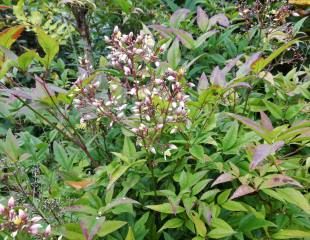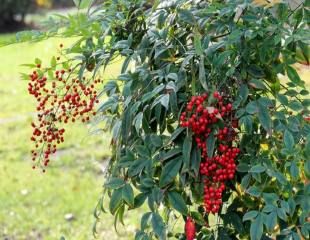


How to grow Nandina, common name Heavenly Bamboo
Nandina is one of the best evergreen garden shrubs with all year round interest.
In the right place, Nandina produces white flowers, berries and a strong autumn colour. It's common names Heavenly or Sacred Bamboo, but it isn't in any way related to a Bamboo. It is safe to grow and not a garden thug or invasive. In fact, its appearance it is quite delicate. Its religious associations in China, where it decorates alters, give it the name Heavenly Bamboo; it's also very popular in Japan.
I am always surprised that Nandina is not more widely grown as it is a lovely, well-behaved shrub. Delicate pointed leaves on arching branches create a lovely, light form. It looks a little like a bamboo in that the stems are bamboo like in appearance. Nandina is becoming more popular. About a decade ago, there were only a handful of varieties offered for sale, now there are over 40. The development of so many varieties means that you can pick a variety of Nandina Domestica ranging in size from 2m to compact shrubs of around .5m
It is also easy to grow as it requires no pruning and, once established, in the right place, requires no maintenance.
One of the best things about growing Heavenly Bamboo is it's all year round colour and interest. When the leaves open they take a red tint, which deepens to a ruby read in the autumn. Nandina like it hot and in a good summer with some heat they will produce white flowers as in the image top left. If the growing conditions are good, there can be a profusion of white flowers followed by bright red berries as in the centre image. The image far right shows the shrub's colorful nature. Nandina has a lot going for it and is not a difficult shrub to grow, despite its delicate appearance.
Nandina has it all, lovely white flowers in the spring, followed by berries and a good autumn colour. For this winning combination, it has to be grown in the right place, and what is the right place? See planting advice below.
Where and How to Plant Nandina Heavenly Bamboo
Nandina originates from the mountain valleys of Japan, China and India and it is fully hardy to H5. Although fully hardy, Nandina grows best in a sheltered spot away from chilly winds in well-drained soil and in full sun. Nandina is happy on most soils, which are neither too wet nor too dry, and prefers soil on the acid side. Once established, it is fairly drought resistant and flowers best in hot summers.
Nandina are attractive shrubs and I recommend planting in an area with some space around it to enable the shrub to stand out. I planted one growing alongside a couple of other shrubs. I later regretted this as Nandina domestica was overshadowed. Planting again, or planting another, I would give it more space to be admired.
It is a low maintenance shrub which does not require feeding or pruning. If it becomes overgrown, prune it in April or May, or after flowering.
Be aware the berries are toxic to cats, although safe and loved by birds.
Best Varieties of Nandina Heavenly Bamboo for the garden
There is quite some variance in the Nandinas commonly offered for sale from large shrubs to compact small shrubs.
Crocus has an excellent selection of compact shrubs, such as N. Pink blush, and Magical Lemon and Lime. (affiliate link)
One of the most popular varieties to grow is Nandina domestica 'Fire power' which, as the name suggests, has a strong fiery red autumn/winter colour and a largish shrub which will reach 1.5m . Nandina domestica 'Richmond' has the RHS garden merit award and is said to be more reliable for producing berries and good colour.
'Sunset' is more upright in form with purple new growth. 'Twilight' changes throughout the year. The newest leaves start out pink with white variegation, which changes to green and white, and then just green. It is a medium-sized variety at 1.2m.
For smaller gardens, there is a popular variety called "Obsessed" with foliage, which starts red in the spring, turns greener as summer progresses, and then dark red in the autumn and winter. Size60-90cmc with a spread of around40-60cmc. 'harbour Dwarf' an old compact variety up to around 60-90cms. There is also a compact form with zingy citrus lime foliage, called Magical Lemon and lime, both of which are available, with other varieties of Nandina from Crocus (affiliate link)
Not all Nandina produce berries, some N. domestica varieties do, and in particular 'Richmond' which has the AGM reputedly for more reliably producing berries and grows to around 2m. N.'Fire Power' is widely grown in the UK which has good colour but not so good on the berry front.
There are also varieties where the foliage colour tends to be more bronzed than red such as N. 'Seika' a compact variety growing up to .6m and which needs winter protection and 'Sunset' with purple tinges to the foliage. There are smaller varieties suitable for growing in containers such as 'Tuscan Flame' which grows to around 35 cms.

I have tagged Nandina domestica the Heavenly Bamboo as a green wheelbarrow because it is easy to grow, low maintenance and drought resistant.
